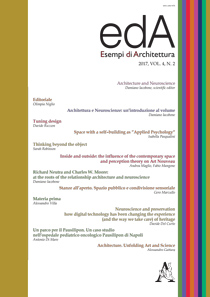Estratto da
ESEMPI DI ARCHITETTURA
International Journal of Architecture and Engineering
Tuning Design
ESEMPI DI ARCHITETTURA
International Journal of Architecture and Engineering
Tuning Design

After the Industrial Revolution, the technical features of architecture gradually acquired an autonomous identity and the strictly functional aspects became dominant. Attention to the human experience of space all but disappeared and recovering the meaning of making for architects, perished along with it. Architects were tightened in a vice, between technical concerns on the one hand and the purely decorative on the other. Inhabitants’ bodies gradually became neutral schemas, economical factors, and at the very least superfluous presences amidst works of abstract art. Meanwhile, one line of resistance, from the second half of the 1800s, was elicited first by physiologists in Germany as Robert Visher, Heinrich Wolfflin, Theodor Lipps, up to the birth of the Hellerau School and later, from the empathic thread of the Bauhaus, until Richard Neutra.1 After the Second World War, this thin line begins to thicken thanks to developments in neuroscience. Today, the merging of several important discoveries (neuroplasticity, the mirror system, the mimetic phase of mind evolution, sensory-motor metaphors and enactment) gives architecture the possibility to protect and design human needs. Through the encounter with a second consciousness, which we can now call architectural settings, we have the possibility to satify deeply rooted human needs, those defined as background feelings capable of satisfying our primary emotions. Through the tools of design we can now orchestrate architectural elements to trigger the embodied simulation of a human gesture, together with its richly emotional layers. The daily feelings pre-cognitively present in the experience of learning, working, leaving, and daily life, architecture can bridge the past with the future. Sensory system resurfaces memories of body gestures, through the gradual assimilation of signals from the architectural space. From the neural traces to the cerebral cortex, this also draws on the emotional core of the movement, producing an attunement between expectations and feelings progressively rebuilt at the conscious level, through the perception of the building’s areas designed to reawaken a range of vital feelings. Architectural design produces places fitted to function, but not in a mechanical sense. Exactly through attunement, settings have the potentil to make humans mindful of their phenomenological essence welding the ancestral roots of their desires and expectations instilling hope for the future.
| pagine: | 11-22 |
| DOI: | 10.4399/97888255087273 |
| data pubblicazione: | Dicembre 2017 |
| editore: | Aracne |








